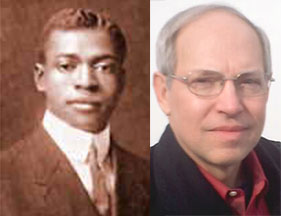by Phillip J. Obermiller
For Black History Month I thought readers of the UACC blog might enjoy reading about the parallels between these two Cincinnati community leaders.
Readers of this blog are probably familiar with Mike Maloney’s background. Coming from Eastern Kentucky’s Breathitt County, he has devoted his career to the service of Southern Appalachian migrants like himself. He was a member of the early Appalachian Committee while working in Over-the-Rhine in the 1960s. After doing graduate work at the University of North Carolina at Chapel Hill, he returned to Cincinnati in 1972 to become a founder and the first director of the Urban Appalachian Council which received partial funding from the United Way.
Readers may be less familiar with the background of James Hathaway Robinson. He was born in Eastern Kentucky’s Bath County and came to Cincinnati in 1915 to begin a career of service to black migrants like himself. After graduate studies at Yale and Columbia Universities, he settled in Walnut Hills. Robinson was a founder and the first director of the Negro Civic Welfare Committee (NCWC), which received funding from the Council of Social Agencies (the forerunner of the United Way). The NCWC, after several name changes, would become the Urban League of Greater Cincinnati in 1949.
|
Michael Eamon Maloney |
James Hathaway Robinson |
So far this may be mere coincidence: two well-educated Kentuckians – one white, one black – coming to Cincinnati to work on behalf of recent migrants like themselves. As we shall see, however, the parallels in their careers run deeper than that.
They presented the facts about their people
One of Robinson’s first actions as director of the Negro Civic Welfare Committee was to conduct a survey of black migrants to Cincinnati which he completed in 1919. The survey covered “the reasons new migrants gave for leaving the South, their religious and economic backgrounds, the housing conditions they found in the Queen City, and the programs of the social service agencies that tried to serve their needs.” Robinson’s careful analysis of the conditions facing blacks in Cincinnati would influence politicians, academics, and social service programming in the city for the next 30 years. His pioneering research was the precursor for “The State of Black Cincinnati,” an ongoing series of reports published by the Greater Cincinnati Urban League.
One of Maloney’s first actions as director of the Urban Appalachian Council (UAC) was to develop quantitative data describing conditions in Greater Cincinnati. His study, “The Social Areas of Cincinnati: An Analysis of Social Needs,” documents levels of poverty, overcrowding, and unemployment as well as educational attainment in the metropolitan area. The report also shows the conditions faced by blacks, Appalachians, Hispanics, women, children and the elderly. Maloney’s decennial updates of this study, which began with the 1970 census, have informed social service decision making in the city for over fifty years.
They organized their people
Under James Robinson’s leadership during the 1920s the Negro Civic Welfare Committee became an umbrella organization for coordinating “the work among colored people.” The Committee’s advocacy presaged that of the UAC by “calling for self-organization of group consciousness among the city’s black people and for a campaign of education among white people.” It anticipated the Appalachian Festival by sponsoring annual Negro music festivals in the city’s public parks during the 1930s and 1940s.
Under Mike Maloney’s direction during the 1970s, the UAC engaged in advocacy on behalf of Appalachians across the city and beyond, assisted neighborhood groups in mobilizing, organized university courses and conferences around the urban Appalachian experience, and offered general assistance to its constituency. The Council also fostered the development of neighborhood-based learning centers and cooperated with the Appalachian Community Development Association in producing an annual Appalachian Festival.
They shared the same principles
Both Maloney and Robinson made it clear that their people faced problems with housing, education, and employment not “because of some lack of moral rectitude or social or cultural defects or problems in character.” Rather, they pointed to larger social forces such as “the shift from a rural agricultural life to an urban industrial one and the family stress caused by inadequate income and housing.”
James Robinson campaigned for a better understanding of black culture and the conditions his people faced on a daily basis; a half century later Mike Maloney would be doing the same for Appalachians. Over the course of the twentieth century these pioneering leaders identified the problems and worked relentlessly for solutions on behalf of blacks and Appalachians in Cincinnati.
(All quotes are from Andrea Tuttle Kornbluh’s, “James Hathaway Robinson and the Origins of Professional Social Work in the Black Community,” pp. 209 – 231 in Henry Louis Taylor, Jr., ed., Race and the City: Work, Community and Protest in Cincinnati, 1820-1970. (Urbana: University of Illinois Press, 1993). See also Thomas E. Wagner, Phillip J. Obermiller, and Melinda B. Wagner, “Fifty Years of Appalachian Advocacy: An Interview with Mike Maloney,” (Appalachian Journal, 40, 3-4:174 – 218, 2013) and Wagner and Obermiller’s Valuing Our Past, Creating Our Future: The Founding of the Urban Appalachian Council. (Berea, KY: Berea College Press, 1999).


Phil Obermiller’s piece on Robinson and Maloney is a gem. Now I understand (even) better the genesis and themes of their seminal work, “African-American Miners & Migrants: The Eastern Kentucky Social Club.” And all this while I thought Dr. Obermiller was [just] a fine sociologist; he’s also a very insightful and analytical historian.
I enjoyed reading more about Michael and how he has helped shape the environment for serving the people of his region as well as far past that.
The parallels are very interesting
Thanks for sharing